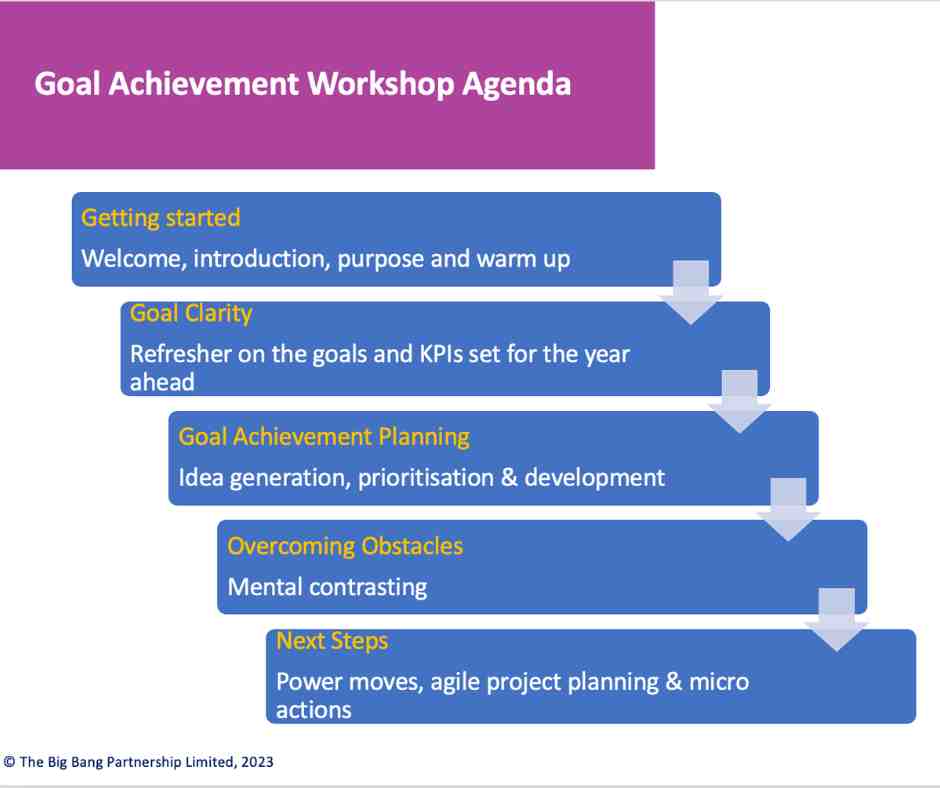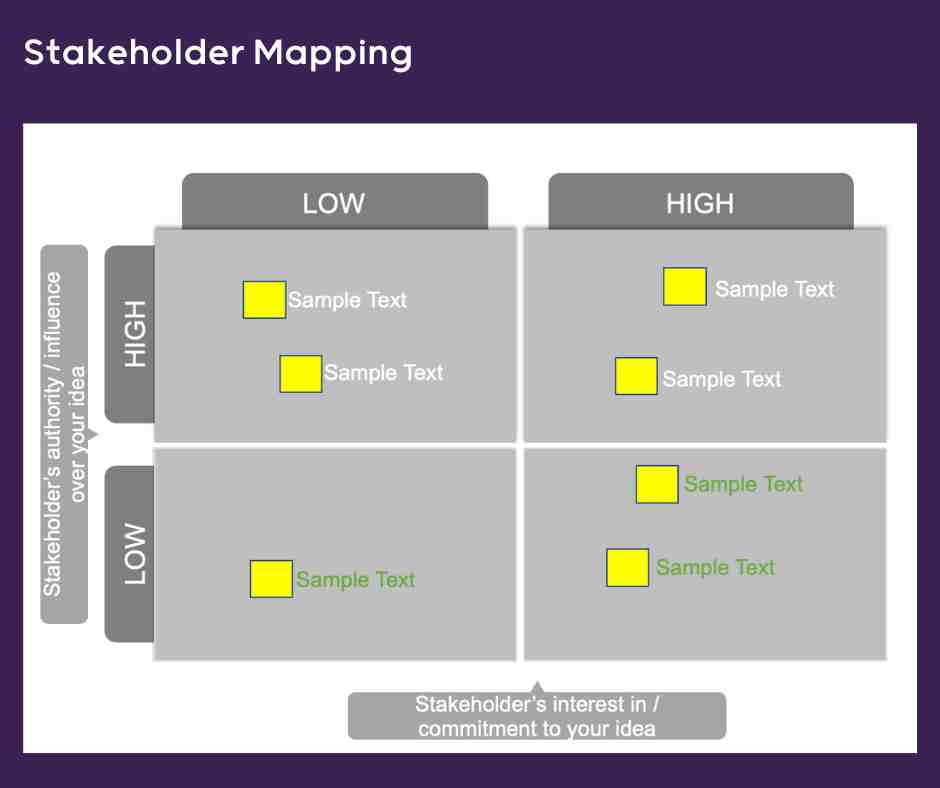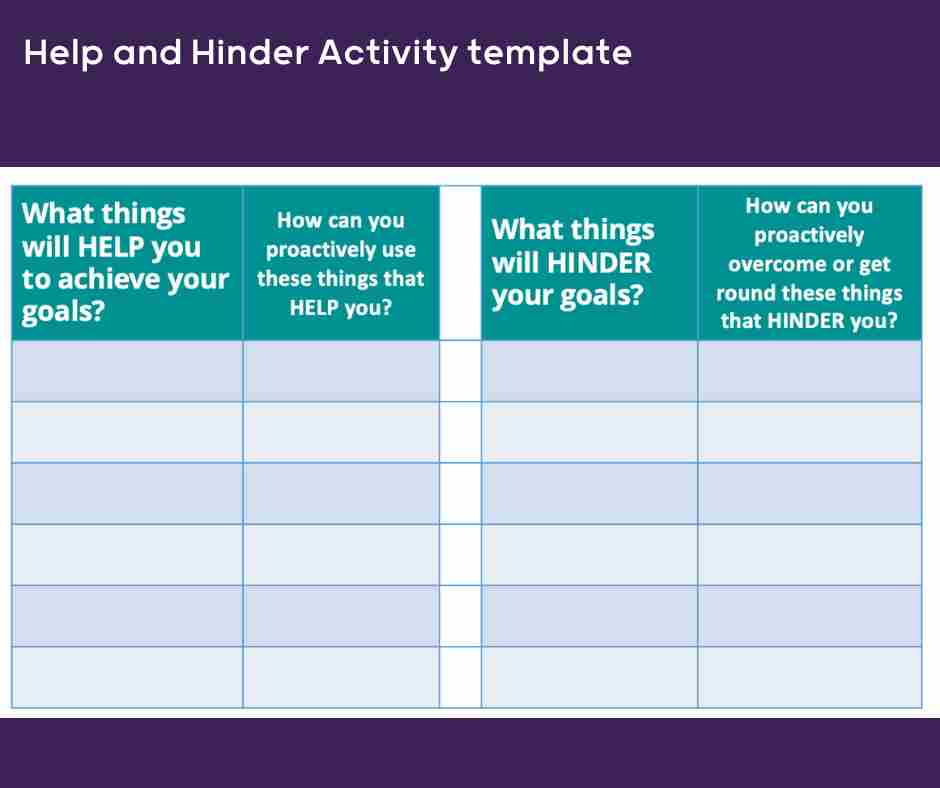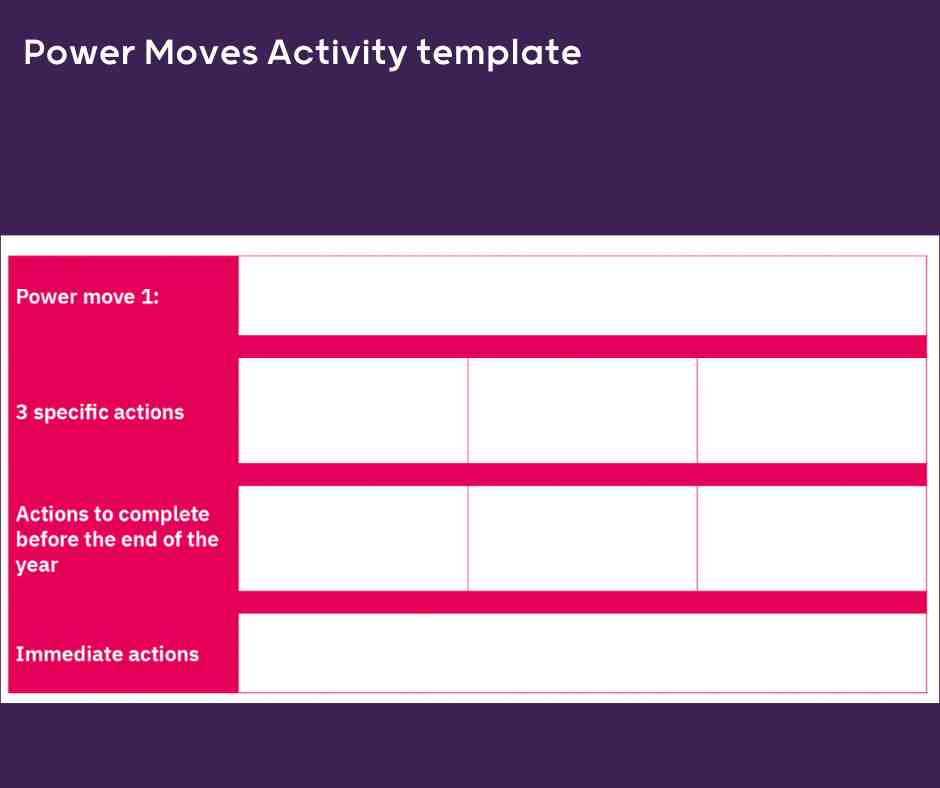Posted in Blog, Entrepreneurship, Facilitation, Innovation, Intrapreneurship, Lead Your Team, Virtual Facilitation by Jo North
Business Goal Achievement
Are you and your team excited and ready for your business goal achievement in the year ahead?
Have you got clear plans in place to achieve them, with contingencies mapped out in case other things get in the way?
In this article I’ll be sharing evidence-based insights, tools, and approaches on how to facilitate a goal achievement workshop for your business, or a mini “retreat” if you’re working on your own.
Facilitating a goal achievement workshop for your team will de-risk your important business goals falling by the wayside as the year progresses!
I’ll help you to act smarter, build and maintain momentum over weeks and months, and identify strategies for likely obstacles before they happen.
You’ll get a full agenda and activities for a time-efficient team workshop or individual away day that will give you clarity and greater motivation for sustained action.
Plus, check out my article here for additional, practical, evidence-based on how to stay motivated to achieve your goals.
Why Goal Setting is Important for Your Business
Goal setting is important for your business because it creates and communicates direction, which over time helps you to achieve your organization’s purpose and vision.
If you haven’t set your business goals yet, please have a look at my detailed article here on how to facilitate a goal setting workshop for your business and start there. Then, come back to this article. You will need to have identified your goals before you and your team progress to the activities I share here.
How to Achieve Business Goals
To achieve your business goals, you will need to ensure that the following critical success factors are in place:
- Your team has goal clarity. Goal clarity simply means that everyone involved in pursuing them has a crystal-clear understanding of what the goals are, why they are important and what the measures of success are.
- The focus is on activities that make a meaningful contribution to goal achievement. The term I use for these activities is power moves, because they propel progress and add up to a significant step change. Focus on agreeing the highest potential power moves instead of creating a long list of indiscriminate, mainly inconsequential actions.
- Convert your power moves into micro actions, with defined timescales. Use the compound effect to optimize your goal achievement as a team.
- Forecasting the likely internal and external obstacles ahead. Create a plan for how you will handle them before they happen. Psychologist Gabriele Oettingen refers to this as mental contrasting. She created the acronym WOOP for it, standing for the process of Wish, Outcome, Obstacle, Plan.
- Remember that what gets measured gets done. Also, that our actions go where our focus lies. To maintain team motivation, momentum and consistency, measure, review and discuss progress and performance against your goals frequently. Work in agile project format, so that you regroup as a team every couple of weeks to assess you actual vs target performance as a team, and course correct as necessary.
Why a Goal Achievement Workshop is Important
Of course, once you have defined your business goals, the next step is for the team to develop strategies and plans to achieve them.
Facilitating a goal achievement workshop for your business brings important benefits.
Benefits of a Business Goal Achievement Workshop
Goal Setting and Motivation
Setting new business goals often feels fresh, dynamic and motivational, even if those goals are challenging. But once the novelty wears away and we get back to the reality of the day-job, enthusiasm and focus can wane. Our best laid plans are sometimes frustrated by events that are difficult for us to control. In addition, automatic routines and old behaviors can just take over. It takes time and effort to instil new habits.
You can integrate the scientifically-supported tools and techniques that I share here into your workshop to create goal achievement strategies that maintain motivation and momentum. You can also successfully foresee and plan to overcome likely obstacles in advance.
Team Collaboration
A well-planned and facilitated goal achievement workshop will support the development of your high performing team. Working together, your team will be able to spot synergies, reduce the risk of duplication and identify ways to help one another. Everyone will have a shared understanding of who will be doing what to make your business goals happen.
Using Neuroscience to Achieve Goals
For a really deep understanding of the neuroscience of setting, assessing, and pursuing goals, the Huberman Lab podcast video below is a great resource. It explains the neural (brain) circuits that underlie goal setting and pursuit.
You’ll also find my article here on intentional goal setting very useful as well.
Agenda and Activities for Your Business Goal Achievement Workshop
Here is the outline agenda and ideas for facilitation activities for your business goal achievement workshop:
- Getting Started
- Goal Clarity
- Goal Achievement Planning
- Idea generation, prioritisation and development
- Facilitation ideas: Sticky note clustering; Lotus blossom
- Idea generation, prioritisation and development
- Overcoming Obstacles
- Mental contrasting
- Facilitation ideas: Bullet-proofing; Stakeholder Mapping; Help and Hinder; If…., then…
- Mental contrasting
- Next Steps
- Power moves, agile project planning and micro actions
- Facilitation ideas: Blockbusters; Power Moves
- Power moves, agile project planning and micro actions

Getting Started
The first agenda item in your goal achievement workshop is of course the introduction and welcome. Remind everyone of the purpose of the session. Go through the agenda. Use a well-chosen icebreaker or warm up to help get your team’s focus on the workshop content and activities.
Goal Clarity
Revisit the goals and Key Performance Indicators (KPIs) that you have set. Check in with how you are doing so far against where you wanted to be. Make sure that everyone is clear on what the goals for the year are, and why they are important. I suggest you do this through a simple presentation.
Goal Achievement Planning
The next phase is for the team to generate ideas for how they might achieve their goals. Choose from one of two facilitation techniques here – either sticky note clustering or the lotus blossom creative technique.
Sticky Note Clustering
- Ask people to focus on each of the business goals. If you have a number of business goals and a large enough group you might want to get smaller breakout groups to each work on a different business goal.
- Explain that the activity has a couple of key stages and that you will explain each as you go along.
- Each person is to work individually at first. They will take a pile of post-it notes and a pen, and get as many ideas for how to achieve the business goal(s) down on the post-it notes as they can, writing only one item on each post-it note. Make sure that people don’t put more than one item on a post-it note.
- After a short period everyone will have a pile of written sticky notes in front of them.
- Ask your delegates to work in small groups to “cluster” their ideas on the sticky notes into similar themes on the flip chart paper or virtual whiteboard, a bit like playing the card game “Snap”. They should place ideas that no-one else has as a cluster of one item.
- Ask the groups to put a ring around each cluster and give it a name that summarises the content.
- Ask each group to feedback on the contents of their clusters. Note similarities and differences. Vote on the priority and / or most productive ideas for achieving each of the business goals, writing out the final list for everyone to see.
Lotus Blossom Creative Technique
The lotus blossom creative technique is such a favorite of mine that I have created a dedicated how-to guide and video for it! Here is the article on how to facilitate the lotus blossom workshop activity. I’ve inserted the video for you below. Ask the team to work in smaller breakout groups to create a lotus blossom grid for each goal.
When everyone has completed their lotus blossoms, ask each group to feedback. Note similarities and differences. Vote on the priority and / or most productive ideas for achieving each of the business goals, writing out the final list for everyone to see.
Overcoming Obstacles
Facilitation ideas for overcoming obstacles to achieve your business goals are:
- Bullet-proofing
- Stakeholder mapping
- Help and hinder
- If…then…
Select one or more of these for this business goal achievement workshop agenda item.
Bullet-proofing
This activity will surface the risks and potential opportunities for the ideas selected in the earlier Goal Achievement Planning task.
Ask delegates to work in breakout teams to complete both risk and opportunity versions of the template below for each selected idea, adding in a potential risk mitigation or opportunity building action for every significant item.

Stakeholder Mapping
A stakeholder is anyone who has an interest in, or will be affected by, your business goals.
Creating a stakeholder map will help the team to think about who they need to engage, influence and collaborate with.
The approach is based on the Winstanley et al. Stakeholder Power Matrix.
First ask your team to work in small breakout groups to brainstorm all the stakeholders who are interested in, or affected by, each of the business goals. They should write the name of each stakeholder on a separate sticky note.
Still in breakout groups, the team should then draw a 2×2 grid, like the one shown below. On the horizontal axis they should write “Stakeholder interest / commitment”, and on the vertical axis “Stakeholder influence / authority”.
The next step of for the groups to discuss where each of the sticky notes should be on the grid:
- High interest / High influence – for stakeholders who can make or break the successful achievement of the goal AND who are highly committed to supporting it
- High interest / Low influence – for stakeholders who have less say over if or how the goal is achieved, but have a strong interest in the process and / or outcome
- Low interest / High influence – for stakeholders who can make or break the successful achievement of the goal AND who ARE NOT highly committed to supporting it. They may even be against it.
- Low interest / Low influence – for stakeholders who are neither interested nor influential.

The final step is for the teams to shape communication and engagement plans as follows:
- High interest / High influence – how to maintain stakeholder support
- High interest / Low influence – how to keep interested stakeholders appropriately up-to-date
- Low interest / High influence – how to influence stakeholders for greater commitment and support
- Low interest / Low influence – how to monitor this group for any changes
Help and Hinder
Help and hinder is a nice alternative to the bullet-proofing activity above.
Ask the team to make a list of all the the things that are helping them to achieve the business goals. They should make another list of all the things that hinder achievement of the business goals. You can use a version of the Help and Hinder activity template below.
The next step is to rank each of the items in the lists, highlighting the most important ones.
Finally, focusing on the priority items, the team thinks about how they will proactively use the things that will help, and either overcome or get round the the things that will hinder. Make sure they write their plans down.

If…then…
To facilitate the if…then… activity, first ask the team to brainstorm all the things that are likely to happen (helpful and unhelpful things) as they work towards their goals. For example, they may see budget cuts ahead, or foresee winning a new business contract. Again, they need to write each item down.
Then ask your participants to put these likely or potential events into the following sentence, using the If…then… structure. They will create a plan of action that they could take if and when each event actually happens. For example:
- If we have budget cuts [the event], then we will do the graphic design for the programme inhouse [plan of action].
- If we win the new XYZ contract [the event], then we will hire an interim project manager [plan of action].
Next Steps
You’ll need to leave with some clear next steps, so that everyone in the team understands what they need to do to achieve the business goals. Use the Blockbusters followed by the Power Moves facilitation techniques here.
It is important that you ask everyone to review and consider all their work so far as they complete the following activities.
Blockbusters
If you’re UK-based, you may remember the 1980s quiz show called Blockbusters? Teenage contestants had to get from one side of the game board to the other by answering questions. (I confess to appearing on the show myself!).
This technique is based on a similar (sort of!) principle, and it is really useful for action planning and helping delegates to visualise moving from where they are now to where they want to be.
First ask delegates to write down the key aspects of where they are now on sticky notes (one item per sticky note) and put them down the left-hand side of a piece of flipchart paper, landscape, or virtual whiteboard.
Then delegates are to place the business goals and KPIs, this time placing the sticky notes on the right-hand side of the paper or whiteboard, each one aligned to a relevant note on the left-hand side. For example, if they have a sticky note that says ‘struggling for sales’ on the left, they might have one that says ‘increase turnover by 35%’ on the right, both positioned level with each other.
The final step is for delegates to fill in the space between with the 5 key actions for each item that will get them from where they are now to where they want to be. These can be different and separate actions, and don’t have to be in chronological order.
Make sure delegates add in target timescales and owners for each action as well.
Power Moves
For each of the five moves – Power Moves – per business goal from the previous Blockbusters activity, the team will create a hierarchy of actions.

Break each of the five Power Moves down into three specific actions.
Then break each of those specific actions into actions that need to be completed in a few months’ time.
Finally, create micro actions, or small, immediate actions, from those that need to be completed in a few months.
Make sure the team captures who will be accountable and responsible for each action, and the target completion dates.
Agree when the team will meet again in the future to begin an agile approach to business goal achievement.
Need Some Help with Your Business Goal Setting and Achievement Workshops?
If you have any questions, or if you’d like us to design and facilitate your business goal achievement workshops, please do get in touch. We are very happy to hop on a no obligation Teams or Zoom call with you to discuss what your need and help in any way we can.

